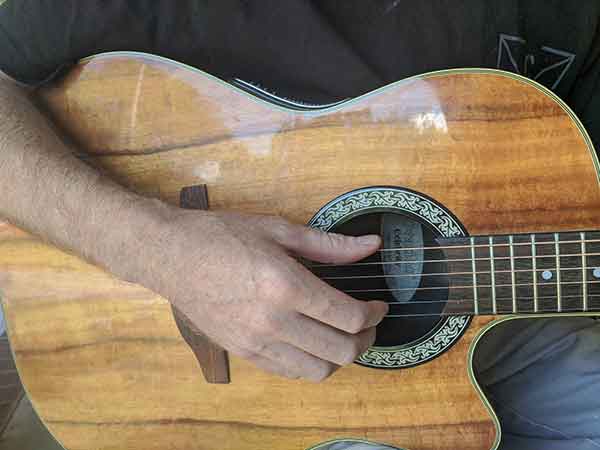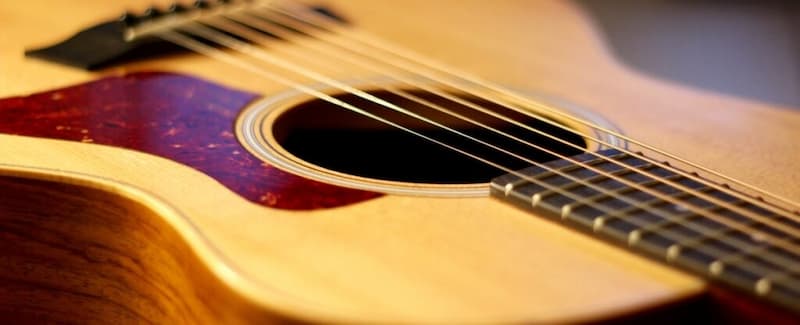
How To Strum Quietly With A Pick: Try These Ways
To begin with, how to strum quietly with a pick?
Just be careful not to strum too hard.
It is quieter to use your finger skin as opposed to your nails or a pick. USE A SOFT PICK ONLY IF NECESSARY.
Reduce the volume of your electric guitar’s amplifier and/or instrument. Or use a practice headphone amp. Or use NO amp.
I personally keep a cheap, already-quiet classical guitar with one of these “feedback busters” installed to further tame the volume for practicing at night.
The soundhole cover reduces volume by about 25% overall, but because bass frequencies tend to “carry” more, the effect is a little better than the percentage would imply.
The volume can be further decreased by placing a mute under the strings close to the bridge, but the tone is changed and the sustain is slightly diminished.
I will do that on occasion. This is an excellent application for a foam Nerf dart from a dart gun. It fits snugly up against the bridge and is cheap, soft, and doesn’t damage the instrument, allowing you to still get some sustain.
Please continue reading if you’re interested in learning more…
Table of Contents
Holding Your Guitar Pick With Less Tension
When you pluck your strings with a guitar pick, noise is produced. Since your fingers absorb some of the energy when the guitar pick strikes the strings, holding the pick more loosely will greatly assist you.
We have published an article called “How to hold a guitar pick”, which contains everything you need to know to master this trick.
One thing that can be helpful when recording your tracks is to give your instrument a little more volume compared to the other instruments. This approach is frequently used in recording studios to aid in the relaxation of the guitar players.
Whether you are planning a studio session, a jam with your friends, or some solo relax sessions at home, a conscious warm-up before playing guitar is mandatory.
Trying Different Angles When Plucking Your String
The most frequently discussed aspect of guitar pick noise is the angle of the pick in relation to the strings.
In general, your pick makes less noise the less it makes contact with your guitar strings. To the strings, slant the pick slightly.
When pulling on your string, experiment with different angles. This will require a conscious adjustment from your side, but once mastered will allow you to vary the attack of the pick more easily.
You will need a different attack angle depending on the guitar pick you are using, the music style and techniques you are using, and your level of skill, so spend 30 minutes figuring out which one works best for you and getting accustomed to playing this way. See more about How To Crack Egg With One Hand Perfectly?
Is Your Picking Team Strong Enough?
Sometimes when you are playing the flow takes over, you mentally leave the room and get into “the zone,” that lovely state where you sound better than usual.
We become so engrossed in the music that we just naturally pick more aggressively.
One of the most frequent causes of guitar pick noise is using too much force. It can also stifle the sustain and make the decay of the notes you are playing much less organic.
Nylon Guitar Picks Are Less Noisy
Both the tone and the noise the plectrum makes are impacted by the material of the guitar picks.
Nylon is considered to be one of the least noisy formulas when it comes to industrial materials used for guitar picks.
This is a result of the substance’s resilience, which, as a result of its mechanical properties, enables it to effectively absorb powerful impacts.
At Rombo, we use a modified form of nylon, which gives the guitar picks more durability and increases their lifespan. Since nylon guitar picks degrade very quickly, this was required. You can learn more about the materials here.
If you are not sure if you are using the right guitar pick, a good option is a variety pack, which contains guitar picks with different attributes. This is an effective way to evaluate various picks and monitor your growth as you start to get better at each one.

The Right Guitar Pick Thickness
It may seem counterintuitive, but you can generally assume that heavier picks will be less noisy. But, why is that?
When strumming or using very thin picks, the picks will bend as they leave the guitar strings, producing a kind of click sound. This occurs frequently when playing an acoustic guitar because the instrument’s body serves as an amplifier for the sound.
With heavier picks, each string can make its own noise without much unwanted interference.
The variable thickness, included in all our guitar picks, not only improves the control but also reduces the noise. The plectrum’s tip is thinner and more flexible, while the body is thinner and more rigid. By having this feature, the tip’s overall flexibility is decreased while maintaining its original thickness and composition. More control and less noise are the results of this.
guitar picks—thick and thin. All the factors that matter are covered in this article.
A Beveled Edge Can Help You Reducing The Pick Noise
Beveled edges on guitar picks will improve sliding and reduce noise. They can significantly reduce the pick noise when combined with the angle of attack that we already mentioned.
Additionally, the pick’s size and shape are significant, though this is more a matter of personal preference.
Reduce Pick Noise With A Polished Tip Guitar Pick
The effect a polished tip has on the tone and toughness of a guitar pick has been a topic of frequent discussion.
A polished tip also glides quite easily over the edge of the guitar string. Conversely, when played on the edge, guitar picks with a rougher tip will produce more treble response. Additionally, when the picks begin to deteriorate, this occurs.
However, as mentioned at the beginning of the article, some purist guitarists even prefer the pick to create noises and they included it extra in their recordings.
Read about: How To Draw A Pinecone?
FAQs About How To Strum Quietly With A Pick
How Do You Strum Softly?
Here are six things you can do right away to enhance your tone and strum like a pro:
- The majority of your motion should originate at your wrist. …
- Hold Your Wrist Free. …
- Go Quickly and Lightly.
- Equalize the volume..
- Change Up Where You Strumming…
- Angle Your Pick.
I Strum, But Why Does My Pick Sound So Loud?
Using very thin picks in combination with fast-playing, like strumming, will cause the picks to bend as they leave the guitar strings, creating a kind of click noise.
Is My Guitar Really That Loud?
If you’re hearing noise, buzz or hum that’s as loud or louder than your guitar, you may have a bad ground inside your guitar.
Can Neighbors Hear The Acoustic Guitar?
You can play acoustic guitar softly or loudly. If you strum hard the sound can travel through apartment walls, and could be too loud for your neighbors during late nights or early mornings.
Why Does My Strumming Sound Harsh?
Your guitar may not sound good when strumming for the following three reasons: Out-of-tune: even one string slightly out of tune can make strummed chords sound bad.
Is Playing Guitar Difficult?
If you are at the stage in your guitar playing where strumming through the chords of a song is a difficult endeavor, don’t worry, you are not alone with this feeling of frustration. Most guitarists experience this stage at some point or another.
Can You Over-strum A Guitar?
Strumming Too Hard: It’s crucial to practice a balanced strum.
Why Is The Sound Of My Pick So Loud?
First, sound is felt when objects jostle around in your ear, which is typically brought on by air jostling. Moving your pick through the air therefore causes sound, and striking the strings is amplified by the guitar, creating even more sound.
Can You Play The Electric Guitar Quietly?
With electric guitar, you have the advantage of being able to practice quietly, as the instruments themselves make very little noise. You can jam in private by connecting them to an amplifier with a headphone jack or to a computer using an audio interface.
Can You Play The Guitar While Wearing Headphones?
Exist headphone jacks on guitar amplifiers? Yes, most modern amps have headphone jacks.
How Do You Quietly Practice Classical Guitar?
Re: Practicing at night
You can try stuffing wadded tissue under the strings, just above the bridge.
Conclusion
So, how to strum quietly with a pick?
Aim to release some of the pressure on the pick’s BACK by rolling your thumb and finger.
The pick’s business end, which sweeps the strings, is more flexible, but you can still press down hard enough to keep it in place.


